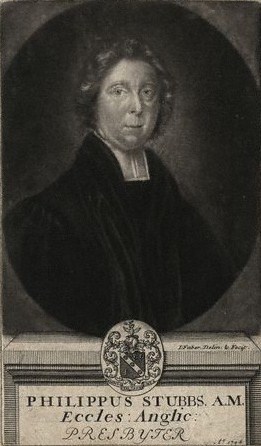Philip Stubbs (priest) facts for kids
Philip Stubbs (born 1665, died 1738) was an important English church leader and writer. He was an archdeacon of St Albans, which is a high-ranking church position. He was also a Fellow of the Royal Society, meaning he was part of a famous group that promotes science. During his life, many of his speeches (called sermons) were published. Philip Stubbs was very active in helping others through Christian groups and social work. He even started several schools for children.
Contents
Philip Stubbs's Early Life and Education
Philip Stubbs was born on October 2, 1665, in London, during a time called the Great Plague of London. His father, also named Philip Stubbs, was a London merchant.
From 1678 to 1682, Philip went to Merchant Taylors' School. After that, he went to Wadham College, Oxford, in 1683. He became a scholar there the next year. He earned his first degree (B.A.) in 1686 and a master's degree (M.A.) in 1689. He became a fellow of the college in 1691.
Church Career and Public Service
After becoming a priest, Philip Stubbs worked as a curate in London. He then served as a chaplain to two important people: Robert Grove, who was a bishop, and George Hastings, 8th Earl of Huntingdon.
From 1694 to 1699, he was the rector (head priest) of a church in Woolwich, which is now part of London. He was also chosen as the very first chaplain for Greenwich Hospital, a job he held until he passed away. After leaving Woolwich, he became the rector of two more churches in London: St Alphage London Wall and St James Garlickhithe.
Philip Stubbs was elected a Fellow of the Royal Society in 1703. This shows he was interested in learning and discovery, especially in literature and history. A famous writer named Richard Steele once heard Stubbs preach and wrote good things about him in his popular magazine, The Spectator.
In 1715, Philip Stubbs became the archdeacon of St Albans. Four years later, he also became the rector of a church in Launton, Oxfordshire. He cared a lot about educating children who were not wealthy. He helped start day schools in the areas where he served, including St Alphage, St James, and Bicester.
Philip Stubbs died on September 13, 1738, in Launton. He was buried in the old burial ground of Greenwich Hospital.
Philip Stubbs's Important Work
Philip Stubbs published many of his sermons and speeches. In 1704, he collected some of them into a book. One of his famous sermons, called ‘God's Dominion over the Seas and the Seaman's Duty,’ was even translated into French. It was given to French sailors who were prisoners at the time.
He was also one of the first people to support the Society for the Propagation of the Gospel in Foreign Parts. This group helped spread Christian teachings in other countries. He wrote their first report in 1703. In 1711, he was chosen to preach a special sermon at St Paul's Cathedral. The Queen had asked for money to be collected for the society that day. His sermon, ‘The Divine Mission of Gospel Ministers,’ was also published.
Philip Stubbs also played a big part in growing the Society for Promoting Christian Knowledge. This group worked to promote Christian education and literature.
Philip Stubbs's Family
In 1696, Philip Stubbs married Mary Willis. She was the daughter of John Willis, a rector from Essex. They had two sons and one daughter who survived. Mary lived for 21 years after her husband passed away. She lived in a special college for the widows of clergymen. She died in 1759 at the age of 95.
Philip Stubbs's only sister, Elizabeth, married Ambrose Bonwicke, who was the headmaster of Merchant Taylors' School.


